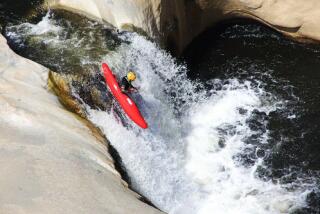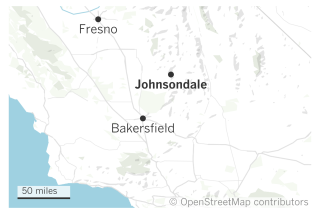‘The Toddler Was Gone’ : Drowning Death of Child Prompts Warnings on Back-Yard Safety
- Share via
After one young child drowned and another came dangerously close to drowning in separate back-yard spa accidents in the San Fernando Valley this week, health and safety officials issued warnings to parents and pool owners to exercise extra vigilance as the weather warms up.
“The first thing you need to do if you have a pool and young children is to have a gated pool area,” said Joy Townsend, a safety specialist supervisor at the American Red Cross. “And that gate should be kept locked, and it should be high enough that small children can’t crawl over it.”
On Thursday, 13-month-old Garrett Edwards drowned in his family’s whirlpool spa in Winnetka after his sister accidentally left the gate to it unlatched, police said.
Less than an hour later in Reseda, Anissa Durham, 18 months old, was found by her mother floating in her family’s back-yard spa, which was ungated. Rescue workers revived the toddler and rushed her to Northridge Hospital Medical Center in extremely critical condition. By Friday evening, however, the girl was improving, a hospital spokeswoman said, and her condition was upgraded to serious and stable.
“We were going to get a pool cover this month,” said a tearful Dawn Nacua, Anissa’s mother, as she waited at the hospital with family and friends for word about her daughter. “We had talked about it just the other day.”
In both accidents, police said parents were just a few feet away from their children when the accidents occurred. The toddlers were out of sight for only a couple of minutes.
Garrett’s father, Richard Edwards, was working on a boat in the garage while watching his 6-year-old daughter and Garrett, police said.
The girl had been inside the spa area earlier in the day picking flowers, police said. She inadvertently left the gate unlatched.
“The dad turned around and noticed that the toddler was gone and then ran out to the Jacuzzi and noticed him inside,” said Officer Sue Carnahan of the Los Angeles Police Department. “The parents were hysterical.”
Garrett was out of his father’s sight for about 10 minutes, Carnahan said.
Nacua, a former Los Angeles County sheriff’s deputy and the mother of a 2-year-old and a newborn, said her family had just moved into the rented Reseda home a month ago and were settling into life with their new child when the accident occurred.
“I went in the back room to check on the baby when my 2-year-old ran up to me and was saying, ‘Anissa, water!’ ” said Nacua. “I saw the sliding door open, and I ran to the pool and saw her floating.”
Nacua said she jumped in and pulled a blue and unconscious Anissa from the water. A maid summoned Nacua’s husband from the shower as Nacua ran into the house carrying the limp child and cleared her throat of vomit. The husband performed CPR until paramedics arrived.
“It is extremely hard for us right now,” Nacua said. “But she is a very strong little girl, and we are encouraged by her progress so far.”
Townsend reminded parents that although a child may have taken swimming lessons, “that training is no reason to not supervise a child in the water.”
“Just because a child does not fear getting into the water, it doesn’t mean they know how to swim,” Townsend said.
(BEGIN TEXT OF INFOBOX / INFOGRAPHIC)
Swimming Pool Safety
Two backyard pool accidents in the San Fernando Valley this week show how children without proper supervision can drown or nearly drown in only a few minutes. A 13-month-old Canoga Park boy drowned Thursday in his family’s backyard spa. An 18-month-old Reseda girl is expected to recover from injuries suffered when she fell Thursday into her family’s backyard pool. Authorities say the toddler was underwater for about five minutes. Rescue workers were able to revive her after performing cardiopulmonary resuscitation.
Most drownings occur when a child is last seen in the house or other area of the yard--nowhere near the pool. For this reason, health officials stress isolating the pool from the rest of the yard with “barrier” fencing.
Many drownings victims are children under 5--in some states drowning is the leading cause of death for this age group--and in California about 100 children a year drown in their own pools. Older children and those who know how to swim are not immune. Statistics show 25% of all childhood drowning victims have had swimming lessons.
A statewide emergency regulation put into effect last year requires barriers between house and pool. In the Valley, when a pool is built, a city Department of Building and Safety inspector visits the site to ensure proper fencing has been installed.
*
Drowning Statistics
There were 125 drowning deaths in L.A. County in 1993, the most recent year for which figures are available. Valley figures:
1991 1992 1993 3- 18-year-olds 3 5 4 0- 2-year-olds 11 7 5
*
Basic Rescue
The American Red Cross recommends “Reach or throw, don’t go” when a child is in danger in pool.
* Reaching assist: If able to reach the victim, use a long object such as oar, paddle, tree branch or towel. Keeping weight low, lean away from victim, lying down or standing with legs bent and feet comfortably spread. Slowly bring victim in, using hand-over-hand grasp on the reaching object.
* Throwing assist: Using throwing device such as ring buoy, stay out of the water and stand with one foot forward and one back, keeping weight low. Hold device in dominant hand and hold extra line in other hand. Use underhand toss, aiming device just beyond victim.
* Enter the water only after above options have been attempted.
*
Health officials recommend layers of protection to prevent pool injuries.
* Fencing: Should be at least 4.5 feet high and made of chain link, wood, wrought iron or masonry. The county Department of Health recommends height of 5 feet, preferably of wrought iron bars no wider than 3 inches apart.
* Self-latching gate: Latch should be at least 4 feet, 10 inches above ground, with latch on inside of fence, facing pool.
* Automatic pool cover: Should be approved by the American Society for Testing and Materials and motorized, with the cover attached by runners to cement, making it difficult for children to fall in.
* Alarm: Install on doors and windows leading to pool.
* Rescue equipment: Life preserver rings, life jackets and shepherd’s crook should be kept poolside. Inflatable toys should not be considered as drowning prevention.
* Cordless phone: Kept near pool for emergencies, with number posted.
* Supervision: Children under 12 should be supervised by an adult who knows how to swim and knows lifesaving techniques and CPR. The American Red Cross offers CPR classes; call 376-1743.
* Swimming lessons: City Department of Recreation and Parks recommends and provides lessons throughout the Valley for children beginning at age 3. The American Academy of Pediatrics warns that lessons for children under 4 may lead to false sense of security. For locations of recreation centers where private and group lessons are offered, call Valley Region Aquatics at 765-0284.
Sources: American Red Cross; Los Angeles Dept. of Recreation & Parks; Los Angeles County Dept. of Health Services; Los Angeles Dept. of Building and Safety
Researched by JULIE SHEER / Los Angeles Times
More to Read
Sign up for Essential California
The most important California stories and recommendations in your inbox every morning.
You may occasionally receive promotional content from the Los Angeles Times.













